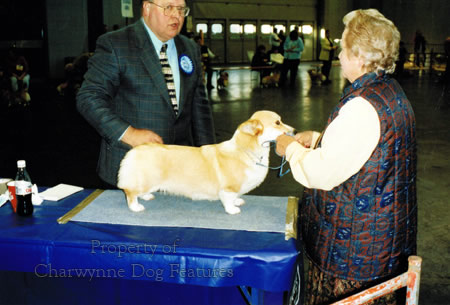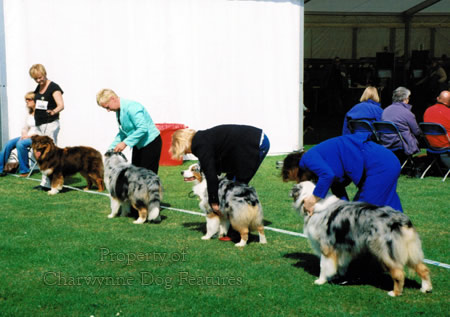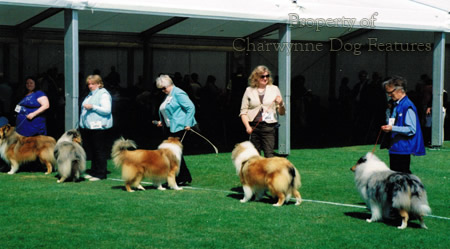479 SHOWING A PASTORAL DOG
SHOWING A PASTORAL DOG - Exhibiting a Functional Dog
by David Hancock
 Judging Criteria
Judging Criteria
How should a working breed, brought in from the pastures, be exhibited and then judged? Should not the paramount desiderata be: soundness of anatomy, powerful movement, hard muscular development and alertness in the eyes. Or, bearing in mind that show dogs are unlikely to do a day’s work, should judges be seeking out show points: the ‘very abundant mane and frill’ in the Rough Collie, the ‘clean wedge of skull’ in the Smooth Collie, the ‘bear-like roll’ in the Old English Sheepdog, the ‘foxy head’ in the Corgis and the ‘great size’ demanded of the Pyrenean Mountain Dog? These features may make the breed but do they make the dog? Who keeps a breed honest? The KC? The Breed Council? Or the judges, when awarding rosettes? The 'rosetted' dogs get bred from; that surely influences the breed more than any collection of words. Judges’s decisions can have far-reaching consequences: in exhibitor expectation, in future breeding choices and in breed morphology.
Showing the Judges
Tapio Eerola, the PR officer of the World Dog Show, held in Helsinki, and editor-in-chief of the Finnish Kennel Club magazine produced these enlightened words in the commemorative issue for that show: "Dog breeders should pay careful attention to which direction they want their breed to go. If the exaggeration of specific features continues in winning dogs the heavy bone structure will get heavier and heavier, short body becomes even shorter, deep chest deeper, wide head wider and long hair longer...Although the World Dog Show is essentially a beauty competition, nothing prevents us from taking up the theme of healthy dog breeding here also." This was highly responsible campaigning by perhaps the most impressive kennel club in the world. There should not and need not be a difference between enthusiastic dog show exhibitors and morally-motivated dog owners; the pursuit of certificates need not preclude the pursuit of healthier-bred, sounder dogs. Nothing but we ourselves prevents us from taking up the theme of healthy dog breeding here as well.
But if you read the judges’s reports on the pastoral breeds in recent years, you can soon see that all is far from well. Take the words on just one pastoral breed’s showing, the Shetland Sheepdog classes, in just one year, 2011: “I struggled to find any with the correct angle of upper arm and shoulder…the worry is that no one seems to be taking any notice and now the lack of angulation is becoming the norm. I found just seven dogs in the entry with anything like the correct conformation.” “Construction still needs to be addressed, particularly steepness and shortness of upper arms…” “…as always shoulder angulation still gives concern, being in some cases short and steep.” And, alarmingly: “I would just like to say that the breeders/exhibitors seem to be concentrating more on head, expression and fullness of coat to the detriment of construction.” “There is more to a Sheltie than a big coat and a pretty face, but there does seem to be a move towards this which is a great worry.”
Built-in Faults
In her The Shetland Sheepdog of 1958, Olwyn Gwynne-Jones recorded that: “All too many Shelties have upright shoulders (insufficiently angulated with too short an upper arm) and straight stifles giving a characteristically wooden and stilted gait.” Half a century later, the very same faults are commonplace. That alone is a commentary, firstly, on the breeders in this charming breed, secondly, on the breed elders and, thirdly on the system in which flawed dogs can be exhibited with the same faults, decade after decade. Is there no overseeing of breed quality in our pedigree breeds? We have Breed Councils, a level above the breed clubs, but do they ever take action when chronic persistent faults afflict a breed? Clearly, not in this one. There has to be, in any breed from the pastures, a sincere desire by its fanciers to keep the breed honest, to be committed out of affection for their chosen breed, to seek a working construction. Or have such faults become fashionable!
Sadly, the advent of dog shows has offered scope too to those who follow fashion, want to win so much that fad-favouring becomes the ‘zeitgeist’ rather than type and soundness. Fads may be passing indulgences for fanciers but they so often do lasting harm to breeds. If they did harm to the breeders who inflict them, rather than to the wretched dogs that suffer them, fads would be more tolerable and certainly more short-lived. But what are the comments of veterinary surgeons who have to treat the ill-effects of misguided fads? In his informative book "The Dog: Structure and Movement", published in 1970, RH Smythe, himself a vet, wrote: "...many of the people who keep, breed and exhibit dogs, have little knowledge of their basic anatomy or of the structural features underlying the physical formation insisted upon in the standards laid down for any particular breed. Nor do many of them - and this includes some of the accepted judges - know, when they handle a dog in or outside the show ring, the nature of the structures which give rise to the varying contours of the body, or why certain types of conformation are desirable and others harmful."
Kennel Club’s Mission
Having watched the judging at a recent Crufts on Working and Pastoral Groups Day, I can see why such words were forthcoming. Having gone to my first dog show just over sixty years ago, I feel, with enormous concern, that things are getting worse rather than better. In his book, Smythe goes on to say that "...the same may sometimes be written regarding those whose duty it is to formul ate standards designed to preserve the usefulness or encourage the welfare of the recognised breeds." Encouraging the welfare of the recognised breeds has to be the underlying mission of not just the Kennel Club, whom Smythe is pointedly criticising, but every breeder, every breed club and every judge officiating at dog shows. Meanwhile, the disturbing post-show comments by judges of pastoral breeds continues each year:
ate standards designed to preserve the usefulness or encourage the welfare of the recognised breeds." Encouraging the welfare of the recognised breeds has to be the underlying mission of not just the Kennel Club, whom Smythe is pointedly criticising, but every breeder, every breed club and every judge officiating at dog shows. Meanwhile, the disturbing post-show comments by judges of pastoral breeds continues each year:
Border Collies, Ch Show, 2011: “I was disappointed to find such a large number of exhibits with obvious faults, including level bites, short upper arms, poor layback of shoulder, weak necks with no arch, short stepping and crabbing movement…”
Shetland Sheepdogs, Crufts, 2012: “…there were a number of exhibits which appeared too cobby in their appearance due to upright shoulder angulations and shortness in back, which became more apparent when asked to move…”
Bearded Collies, Ch Show, 2013: “It’s five years since I judged the breed and there hasn’t been a great improvement…Short upper arms and forelegs seem to be quite common as well as over-angulated rears…” The faults listed in each critique are serious ones for a pastoral breed, where anatomical soundness is all-important.
Of course, there are some top quality dogs on the show scene; I was impressed in 2013, from the ringside, by exhibits such as Cardigan Welsh Corgi Ch Yasashiikuma Telltail Dbledare, a Canadian import, Aus tralian Shepherd Ch Allmark Fifth Avenue and the Bearded Collie, in Ireland, Ch Firstprizebears John FK, a Galway-based dog. But you have to judge a breed on its depth not its top dogs. So often among show people there is a tendency to seek a regular winner as a sire for their bitch, regardless of her quality and the sire’s record of throwing consistently sound progeny. Breeding good quality dogs demands knowledge, research, informed planning and never pursuing the latest fad, fashion or over-used sire. Judges rate the exhibits in order of excellence in the ring; breeders bear all the responsibility for the exhibits that never win yet still get bred from.
tralian Shepherd Ch Allmark Fifth Avenue and the Bearded Collie, in Ireland, Ch Firstprizebears John FK, a Galway-based dog. But you have to judge a breed on its depth not its top dogs. So often among show people there is a tendency to seek a regular winner as a sire for their bitch, regardless of her quality and the sire’s record of throwing consistently sound progeny. Breeding good quality dogs demands knowledge, research, informed planning and never pursuing the latest fad, fashion or over-used sire. Judges rate the exhibits in order of excellence in the ring; breeders bear all the responsibility for the exhibits that never win yet still get bred from.
In his The Complete Book of the Dog of 1922, Robert Leighton wrote: “The Shetland Sheepdog is a sturdy, altogether admirable little dog, most attractive in appearance, and possessing all the wisdom and sagacity of his larger relative. He is in no sense a toy dog, but in all essentials a reduced replica of the big working Collie, even as the Shetland pony is a small copy of the shire horse, differing only in bulk and weight. In the south he is kept as a very engaging companion and is not expected to the work of a shepherd’s dog; but he ought to be judged with an eye on his fitness for working among flocks and herds.” It’s that last phrase, with its clear advice to judges, that is of the most value; this breed, just like all the others, can only survive in the Pastoral Group if it’s bred to be a pastoral dog, not just casually as an urban pet – ignoring its original design, whatever the pressures of town-dwelling owners and judges following the ‘fashion of the day’. These pastoral breeds are such a vital element in our canine heritage that they truly justify a very careful scrutiny - and not just by the show ring judges. Breed Clubs and especially Breed Councils really must be watchful.